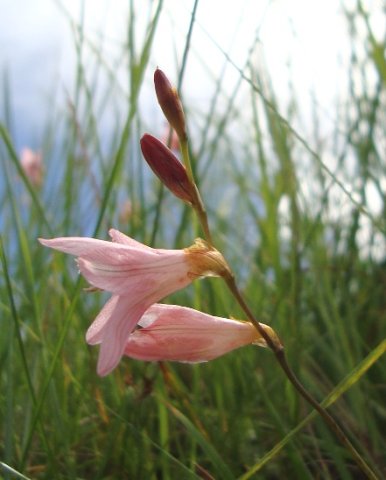Tritonia disticha

Author: Ivan Lätti
Photographer: Judd Kirkel Welwitch
Tritonia disticha, commonly known as the red tritonia or the pink montbretia and previously scientifically as Montbretia rosea, is a cormous, deciduous perennial reaching heights from 25 cm to 60 cm.
The corm is regrown annually on top of the old one. Nutrients are drawn from the old corm which then shrivels and dies as the new one matures and waits for its season to serve. The corm-shape is globose and somewhat depressed, sometimes ovoid, covered in tunics of elongated, reticulated fibres.
The stem is simple or branched, sometimes slightly zigzagging (flexuose) between flowers. The sword-shaped or lance-shaped leaves grow in a closely set fan. A prominent vein is positioned near a leaf margin.
The inflorescence is an inclined spike of four to thirteen flowers. The flowers grow mostly in two ranks, the angle between the ranks and the spacing of the flowers variable.
The species distribution is in the east of South Africa, from the Eastern Cape, the eastern Free State and KwaZulu-Natal to southern Mpumalanga, as well as some neighbouring countries.
The habitat is stony grassland on dolerite or sandstone, from near sea level to the foothills of the Drakensberg. The habitat population is deemed of least concern early in the twenty first century.
The pink flowering form may be or may in future be T. disticha subsp. rubrolucens, and the red one subsp. disticha, but SANBI did not recognise the subspecies at the time of writing.
This plant survives moderate frost. It is a gardening plant or prospect, particularly for containers and rock gardens (Pooley, et al, 2025; Manning, 2009; Pooley, 1998; iNaturalist; https://www.worldfloraonline.org; http://redlist.sanbi.org).

